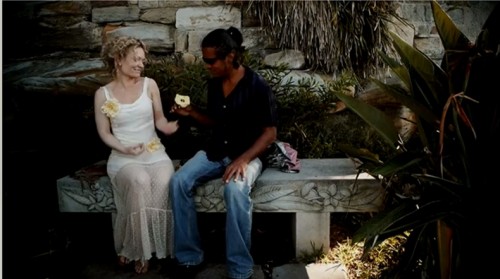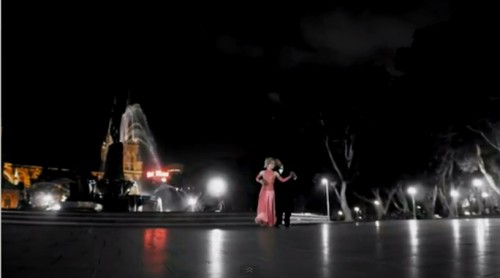Romancing Sydney
 Director: Anmol Mishra
Director: Anmol Mishra
Expected Rating: PG due to some foul language.
Distribution: None
Budget: 23,500 AUD (approximately $24,000 USD)
Genre: Romantic Comedy
Running Time: 105 minutes
Release Dates: January 1, 2013
Website: Click Here
Trailer: N/A
Critique Issue: #87 (05/13)
Critiqued By: Monika DeLeeuw-Taylor
Final Score: 8.3
Microfilmmaker Magazine is happy to provide filmmakers with up to three critiques of their films: rough, semi-final, and final. We previously critiqued the film “Romancing Sydney,” in its semifinal form, under the name “A Walk in Hyde Park.” Because this is a follow-up critique, some things are alluded to or mentioned without going into our normal level of depth, an as such we encourage you to read the original critique first by going here.
Romancing Sydney is a love story between Sachen (Anmol Mishra) and Elisa (Susanna Richter.) The two meet by chance one night – Elisa has been kicked out of her apartment and is sitting on the beach, crying. Sachen’s car breaks down in the same spot where she is sitting, and the two strike up a conversation that leads to a romance
Content
While the plot of Romancing Sydney remains the same as the original, there were many changes made beyond the name. The scene with Elisa and Sachen’s last day together – their walk together through Hyde Park that both bookends the film and is interspersed throughout it – now has a clearer transition and a sound effect to set it apart from the other footage in the film.
Sachen’s relationship with John is also better detailed. In A Walk in Hyde Park, it was explained that John runs a performance group, but was running low on participants, so he advertised. Sachen was the only person who answered the ad, so John was stuck with him. This added more insight into Sachen’s relationship with John, and why there might be some tension between the two of them. Several shots of Sachen doing gymnastics were added, and it looked to me that he was actually quite good. John still complained about the things Sachen was doing wrong, and the fact that he was always late, but that only made John seem like a perfectionist. The problem with this added visual explanation is that it contradicts Sachen’s later statement that he has two left feet. I realize that dancing and gymnastics are two different things, but I would assume that since Sachen can do gymnastics – even if it isn’t to John’s picky satisfaction – he would probably be at least a decent dancer, or he could learn it quickly. At the very least, he doesn’t appear to have two left feet.
The addition of voice-overs is very helpful in explaining the film’s plot quickly, which the previous version had trouble with. There is a brief voice-over and discussion between Elisa and Alex as they are discussing the theme of the dance they are about to perform – (the couple were lovers, but, now, their love has turned to suspicion.) Not only is it helpful for an audience who may not be familiar with the subtleties of dance, but it is an excellent foreshadowing of Elisa and Sachen’s relationship.
Warning! Spoilers Ahead!
As in A Walk in Hyde Park, there is still a scene in which Sachen gets Joh drunk, then coaxes out of him a story about another man who had been flirting with him. Then after John stumbled home, Sachen calls the rival for John’s affections, who takes advantage of his inebriated state. Sachen also calls John’s fiance Alex, and tells him that John is cheating on him – thus destroying their relationship.
I have to say that I still wasn’t completely convinced as to why Sachen would do something like this – it really seems to come out of the blue for his character. At the beginning of the film, he interacts with a complete stranger at his workplace – the “poodle woman” – who is very rude to him, but he is actually very polite and self-effacing towards her. It doesn’t fit that he would be so nice to this woman he didn’t know, and yet so mean to someone who was supposed to be his friend.
This version of the film did add additional dialogue of John belittling Sachen and being mean to him, and this event happened after John makes fun of Sachen at a dance class. But everyone else in the class also laughed at him, and Sachen’s betrayal still seemed more planned than spontaneous.
As I mentioned in the previous critique, since Sachen later uses a slur for homosexuals when referring to John, it seemed like the main reason he didn’t like John was because he was gay, but Sachen never says or does anything that indicates that, until the moment when he is about to break up John and Alex. And if he really had a problem with John’s sexuality, why did he remain in the performance group, and continue to see John as a friend?
Visual
There were no real changes with the film visually, but it didn’t really need any. It was still just as visually beautiful as it was the first time. There is now the added treat of the opening credits – a fast-motion pan around the Sydney Harbor. The text in the credits is also creatively random – each name popping up in a random spot, and fading out one at a time. I’ve never seen opening credits done like this, and it was quite a clever choice. I did notice, however, that during the credits, the camera jumped a couple times. It wasn’t as obvious, I don’t think, because the image was already moving quickly, but it was a bit jarring.
I also noticed that in the aforementioned scene with Sachen and the “poodle woman,” there was one shot where words in the background were backwards, as though the image had been flipped in post-production. I don’t think it was a reflection in a mirror or window – it looked like a sign that was actually in the background. I thought that had been done deliberately to avoid “crossing the line,” (also known as the 180-degree rule, this is a guideline for filmmakers to avoid their characters appearing to “flip” on screen. Basically, an imaginary axis line is used to connect the characters’ actions or interactions, and the camera is supposed to only stay on one side of the line.) But even if I was mistaken about the flip-flopped image, the editing of that scene still looked a little off, as though the crossing of the line hadn’t been completely avoided.
Audio
In the previous version of this film, there were a lot of audio problems. But this time around, nearly all of them had been fixed. Most of the scenes in which the background noise overpowers the dialogue are now much clearer, and it was done well enough that it wasn’t obvious whether this was through a remix, cleanup of the dialogue, or cleverly blended ADR.
In the scene with Alex and John talking in the cafe, however, the background effects bed or actual bleedthrough is still a bit too loud to understand what they were saying. Also, in the final scene, where Sachen is talking to Elisa, but she is thinking about what Alex told her earlier, the volume of Alex’s dialogue is far too quiet, and is overpowered by the sound of the ocean they were speaking in front of. It I’m guessing this is actual bleed through, rather than a mixing error, so it probably needs to be re-recorded in the studio, then have a bed of ocean sounds added gently to the final mix, so the audience can focus on what he is saying. Finally, the scene where Elisa’s landlady kicks her out looks to have been ADRd, but the dialogue doesn’t quite match the lips of the actors, so it looks a bit too obvious. (Audition CS6 has the ability to stretch audio to match original takes, I believe. It might be worth trying out the demo to at least see if it could deal with this issue.)
Budget
The budget for the improvements to “Romancing Sydney” was $300 toward artist fees and re-recording audio, and $200 for the software programs Izotope RX for audio cleaning and Inqscribe for subtitles. The director did the work of the audio himself.
The audio for Romancing Sydney was so much better than the original, I was honestly surprised that more money wasn’t spent! This software was definitely worth it. (Now I see why RX got such high marks when Gabe Gibitz reviewed it here at MFM!)
Lasting Appeal
A Walk in Hyde Park was already appealing and Romancing Sydney is a great improvement over it. The visuals are just as stunning as before, but the improved audio and story lines have made it much more audience-friendly. There may still be some minor work to be done, but the final product has been improved dramatically already!
Closing Thoughts
I often don’t get an opportunity to see a film that’s been re-done, and to be honest there’s a little bit of an ego boost involved when the filmmaker takes my advice. But there’s also a lot of satisfaction knowing that I was involved in helping someone get closer to their dream and improve their craft. I’m looking forward to seeing more from Mr. Mishra, and it better include more excellent dances!
|
Breakdown
|
|
|
Content
|
6.9 |
|
Visual Look
|
9.4 |
|
Use of Audio
|
8.2 |
|
Use of Budget
|
9.0 |
|
Lasting Appeal
|
8.2 |
|
Overall Score |
8.3 |
| How do we critique films? Click Here To See. | |



